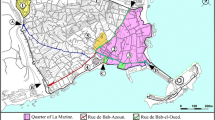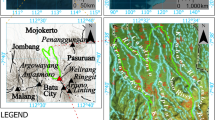Abstract
Our coasts are subjected to constant changes due to both biophysical and anthropogenic processes, which have been severely increasing over the last two centuries. Long-term diachronic observations of geomorphological evolution should allow a better understanding of how and to what extent natural environments and cultural heritage sites have been affected over time. This paper describes the implementation of a pictures-based methodology, which provides an iconographic interpretation of decades-to-centuries coastal landscape evolution. The chosen location for the field studies is the Rance Estuary (France Channel coast), a 20-km-long ria, which has undergone specific changes because of the long-standing presence of industrial buildings such as shipyards and tide mills and the opening of the world’s first tidal power plant in the 1960s. In order to identify the entire range of alterations that have occurred on the estuarial geosystem over time, a large number of artistic representations of the shores (paintings, engravings and postcards) have been used. The vantage points of the different historical images have been located, and current photos have been taken trying to reproduce, as exactly as possible, the same view in order to allow the precise comparison of diachronic pairs of images. The results of its historical landscape record are disseminated through a dedicated website to which consultees, stakeholders and the public, more widely, may access and contribute by sending new pictures from the past. An interactive online map locates the study sites and allows access to the associated observations and comments, whilst interactive graphs give an overview of the changes that have been identified.












Similar content being viewed by others
Notes
Indeed, whilst on one side Dinan, and on the other side Saint-Malo and Dinard, which were copiously represented from the eighteenth century, the river valley in between was largely ignored until the beginning of the 1900s. In a paper dealing with the ‘Images of the river Rance’, Delouche (1987) suggests a possible explanation, namely an administrative division unlikely to enhance the estuary as a landscape entity and a constraining geographical context because of restrictive terrestrial access and a rarity of visual escapes from the valley. Other reasons for a lack of interest in the landscape of the Rance valley itself could include its industrial, functional and rural space, without any prestige, and lacking any stronghold or other important historic monument. Landscapes of the Rance have not captured interest. At that time, artists were not attracted by coastal wetland (Goeldner-Gianella et al. 2011). They preferred sublime cliffs, charming sandy beaches or picturesque fishermen villages. These kinds of landscapes were more in keeping with the artistic vision of beauty at that time, and so more likely to be appreciated by middle-class visitors coming from Paris to enjoy the seaside. As a result, state or touristic guides, artists and lithographers in charge with representing symbolic locations of French territorial significance did not find any reason to erect their easels there.
Roughly, dating can be calculated by measuring excess activity of 210Pb, (210Pbxs) in sediment samples. 210Pb is a 22.3 half-life isotope naturally present in the environment. When atmospheric particles drop down on the interface water/sediments, they introduce this 210Pb. The activity of this 210Pb in excess decreases with depth into sediment, according to both its radioactive period and the rate of sedimentation. The study of the curves of 210Pb allows to date and estimate the rate of sedimentation. Then, to date more precisely on the scale of the last century, estimations obtained thanks to 210Pb can be compared with those derived from 137CS, an artificial radio-isotopy whose middle life is 30 years and which has a pulsed input function linked with atmospheric fallouts of nuclear tests, with maximum fallouts in 1963, and, sometimes, a peak linked with 1986s’ Chernobyl accident. As these two radioelements are gamma transmitters, it is possible to measure it inside sediments from a same gamma count of dry sediments (Schmidt et al. 2014). MBq is short for the term megabecquerel. This unit from the International System (SI) is used to measure the releases from a radioactive nucleus. One MBq corresponds to 0.000001 becquerel.
References
André MF (2017) From physical geography to environmental geography : bridges and gaps (a French perspective). The Canadian Geographer (TCG) Special Issue: Changing Priorities in Physical Geography 61(1):136–142. https://doi.org/10.1111/cag.12335
Blaise E (2017) Shoreline dynamics of Brittany sedimentary coast on different spatial and temporal scales. PHD dissertation, University of western Brittany
Borchia R, Nesci O (2011) The Invisible Landscape. Discovering the real landscapes of Piero della Francesca. Il Lavoro Editoriale, Ancona 86 pages. ISBN : 9788876636646
Bourret J (1997) La Valorisation Agronomique des sédiments marins de La Rance. Courrier de l’environnement de l’INRA n° 31. https://www.7.inra.fr/dpenv/bourrc31.htm. Accessed 10 Jan 2017
Brouard H (1970) Les Bateliers de La Rance. Annales de la Société d'Histoire et d'Archéologie de l'Arrondissement de Saint-Malo (ASHASM)
Bruneau-Chotard (1982) Les moulins à marée de la Rance. Annales de la Société d'Histoire et d'Archéologie de l'Arrondissement de Saint-Malo, Saint-Malo, pp 87–106
Camuffo D (2010) The sea level in Venice according to Veronese paintings, Canaletto and Bellotto. Revue d’histoire moderne & contemporaine (RHMC) 57-3(3):92–110
Camuzard JP (2011) L’exploitation des tangues ou le souvenir des savoirs oubliés. Bull Soc Géol Minéral Bretagne (D) 8:1–32
Chaigneau-Normand M (2002) La Rance industrieuse, espace et archéologie d’un fleuve côtier. PUR, Rennes 270 pages. ISBN: 2–86847–694-5
De Jessey B (1979) Les traversées de la Rance au cours des siècles. Annales de la Société d’Histoire et d'Archéologie de l'Arrondissement de Saint-Malo (ASHASM) 191–205
Delouche D (1987) Images de la Rance. In: Bannalec (ed) De Dinan à Saint-Malo: la Rance Millénaire (Saint-Malo, Dinan, Rennes, Saint-Brieuc). 145 pages
Giusti C (2012) Les sites d’intérêt géomorphologique : un patrimoine invisible ? Géocarrefour, 87/3–4, pp 151–156. http://journals.openedition.org/geocarrefour/8834. Accessed 6 Jan 2018
Giusti C, Calvet M (2010) L’inventaire des géomorphosites en France et le problème de la complexité scalaire. Géomorphologie : relief, processus, environnement 16–2, pp 223–244. https://doi.org/10.4000/geomorphologie.7947
Goeldner-Gianella L, Feiss-Jehel C, Decroix G (2011) Les oubliées du “désir du rivage” ? L’image des zones humides littorales dans la peinture et la société françaises depuis le XVIIIe siècle. Cybergeo : Eur J Geogr [online], Environnement, Nature, Paysage, document 530. http://journals.openedition.org/cybergeo/23637. Accessed 7 April 2018
Grangier L, Kaiser C (2016) Geoheritage is fun! Gamification in smartphone application for geoheritage promotion. International Workshop on Urban Geomorphological Heritage, Rome, pp 27–29 octobre 2016
Langouet L (2002) Histoire de la Rance dans l’antiquité, in Bonnot-Courtois C. La Baie Du Mont Saint-Michel et L’estuaire de La Rance, Environnements Sédimentaires, Aménagements et Évolution Récente. Pau, CNRS, EPHE, Totalfina ELF p 256
Langouet L, Souillet G (1974) Reginca et la baie de Saint-Malo dans l’Antiquité. Annales de Bretagne et des pays de l’Ouest 81(4):653–679
Langouet L, Daire M-Y, Briard J (1993) Meilleurs souvenirs mégalithiques de Bretagne. Inst.Culturel Bretagne, Vannes 82 pages. ISBN : 978–2–86822-051-6
Lanoe G (2016) Synthèses et caractérisations de mousses de verres à partir de déchets. Valorisation de déchets marins et verriers. PHD dissertation, IUT of Saint-Brieux, Science ingenering department
Le Bot (1993) La Rance et ses bateaux aux derniers jours de la voile. Annales de la Société d'Histoire et d'Archéologie de l'Arrondissement de Saint-Malo
Mallet C, Michot C (2012) Synthèse de référence des techniques de suivi du trait de côte. BRGM/RP-60616-FR
McInnes R (2008) Art as a tool in support of the understanding of coastal change in Hampshire and the Isle of Wight. The Crown Estate – Caird Fellowship 2008. ISBN: 978-1-906410-08-7
McInnes R (2016) CHeRISH – Coastal Heritage Risk – Imagery in Support of Heritage Management in South-West England’ Report for Historic England (No. 7145). 263pps. http://cherish.maritimearchaeologytrust.org/. Accessed 5 Aug 2018
McInnes R, Benstead S (2013a) Art as a tool in support of the understanding of coastal change in Wales. The Crown Estate 107 pages ISBN: 978–1–90641042-1
McInnes R, Benstead S (2013b) Art as a tool in support of the understanding of coastal change in Scotland. The Crown Estate. 97 pages. ISBN: 978–1906410–49-0
McInnes R, Benstead S (2015) Art as a tool in support of the understanding of coastal change in Northern Ireland. The Crown Estate. 97 pages
McInnes R, Stubbings H (2010) Art as a tool in support of the understanding of coastal change in East Anglia. The Crown Estate, 92 pages. ISBN: 978–1906410–10-0
McInnes R, Stubbings H (2011) A coastal historical resources guide for England. The Crown Estate. 90 pages. ISBN: 978–1–906410-19-3
Metzger A (2014) Le froid en Hollande au Siècle d’or. Essai de géo climatologie culturelle. PHD dissertation, University of Paris 1 Panthéon Sorbonne
Metzger A (2015) Les temporalités climatiques des paysages d’hiver hollandais. Nouvelles Perspectives en Sciences Sociales (NPSS), Prise de Parole (Ontario, Canada) 10(2):103–121
Metzger A, Desarthe J (2017) Regarde s’il pleut. Effets d’inondations dans la peinture française (1856-1910). Communications 2–101:119–141. https://doi.org/10.3917/commu.101.0119
Meury L (1974) Les pêcheries de la Rance. Réunion de la société d’Histoire et d’archéologie de l’arrondissement de Saint-Malo
Motte E (2014) L’usage de représentations artistiques des rivages comme outil de connaissance de l’évolution du littoral : exemples bretons. Revue d’Histoire Maritime 18:339–357
Motte E (2017) Iconographie et Géomorphologie : l’usage de représentations artistiques des rivages comme outil de connaissance de l’évolution du littoral. PHD dissertation, University of Rennes 2
Nordstrom KF, Jackson NL (2001) Using paintings for problem-solving and teaching physical geography: examples from a course in coastal management. J Geogr 100(5):141–151. https://doi.org/10.1080/00221340108978441
Panizza M (2001) Geomorphosites: concepts, methods and examples of geomorphological survey. ChinSciBull 46(Suppl 1):4–5. https://doi.org/10.1007/BF03187227
Piveteau JL (1965) Peinture et géographie. Le Globe 105-1:9–10
Portal C (2010) Reliefs et patrimoine géomorphologique. Applications aux parcs naturels de la façade atlantique européenne. PHD dissertation, University of Nantes
Portal C (2013) Du socle au paysage : essai pour un nouveau regard sur les reliefs. Projet de paysage 8 http://geomorphologie.revues.org/337 (Consulted 13_11_2016)
Reichler C (2017) Infrastructures et paysage. La route du Simplon dans les gravures de Gabriel Lory (1811). FACES, Journal d’Architecture 73:4–8
Reynard E, Coratza P, Hobléa F (2016) Current research on geomorphosites. Geoheritage 8-1:4–3. https://doi.org/10.1007/s12371-016-0174-3
Schmidt S, Siano R, Andresen C, Massé G, Belt S, Giraudeau J (2014) Dating of sediment over the last century: strategy based on 210Pb and 137Cs. University of Bordeaux, Bordeaux
Tabeaud M, Metzger A (2017) Alexandre HOGUE: peintre du ‘dust bowl. PhysioGéo, Géographie physique et environnement [Revue en ligne] 11:93–106. https://physio-geo.revues.org/5291. Accessed 6 Oct 2017
Thébault H (2015) Gestion des sédiments, propositions 2015, Commission Estuaire Rance
Zerefos CS, Gerogiannis V, Balis D, Zerefos S (2007) Atmospheric effects of volcanic eruptions as seen by famous artists and depicted in their paintings. Atmos Chem Phys 7:4027–4042. https://doi.org/10.5194/acp-7-4027-2007
Author information
Authors and Affiliations
Corresponding author
Rights and permissions
About this article
Cite this article
Motte, E., McInnes, R. Using Artistic Imagery to Improve Understanding of Coastal Landscape Changes on the Rance Estuary (French Channel Coast). Geoheritage 11, 961–972 (2019). https://doi.org/10.1007/s12371-018-00341-2
Received:
Accepted:
Published:
Issue Date:
DOI: https://doi.org/10.1007/s12371-018-00341-2




